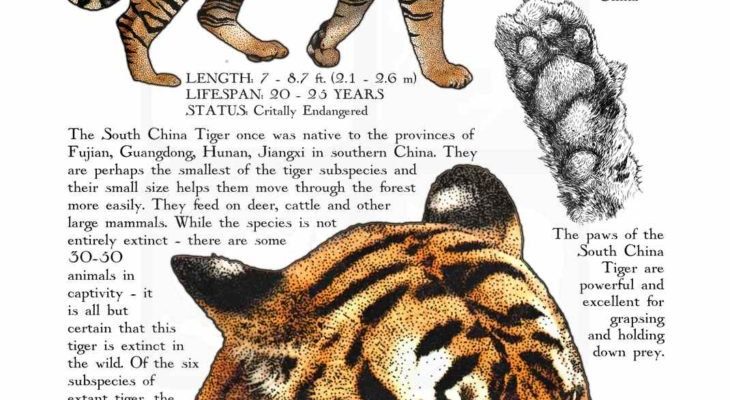
The South China tiger is considered one of the most endangered tiger subspecies, with a history that intertwines deeply with the landscapes of southern China. Unlike its more well-known cousins, the Bengal or Siberian tigers, this subspecies has adapted uniquely to its environment. Think of it as a species fighting to survive in a world that’s rapidly changing. In our journey today, we’ll explore its evolution, habitat, conservation challenges, and hope for the future. So grab your coffee, and let’s dive into the captivating story of the South China tiger!
Understanding the South China Tiger
To appreciate the evolutionary history of the South China tiger, it’s important to first understand what sets it apart. This tiger is smaller than other subspecies, with males weighing between 350 to 450 pounds and females slightly lighter. They possess a distinct appearance: a slightly paler orange coat, closer-set stripes, and a broader skull shape. The South China tiger’s unique features evolved to help it thrive in its specific habitat, which includes subtropical forests and grasslands.
Historically, the South China tiger roamed vast areas of southern China, including provinces like Guangdong and Hunan. Picture a landscape once filled with lush forests teeming with wildlife, providing ample resources for these magnificent predators. Unfortunately, due to habitat destruction and human encroachment, the tiger’s range has shrunk dramatically. Today, it’s believed to be functionally extinct in the wild, with only a handful of individuals surviving in captivity.
The Evolutionary Journey
The roots of the South China tiger can be traced back to a common ancestor shared with other tiger species. The evolutionary journey started millions of years ago, during the Pleistocene Epoch. Picture a time when tigers roamed across Asia, adapting to various climates and environments. Over time, as tigers spread out, they adapted to local landscapes, allowing distinct subspecies to emerge.
Scientists believe that the South China tiger diverged from its closest relatives around two to three million years ago. This period of evolutionary separation led to the development of unique traits that suited the subtropical forests of southern China. For example, their body shape became more agile for navigating dense vegetation, and their hunting techniques specialized in smaller prey common to their environment. This adaptability is a testament to the species’ resilience, even as their habitats faced increasing pressures from human activities.
Habitat and Adaptation
The natural habitat of the South China tiger is a complex tapestry of diverse ecosystems. They thrive in subtropical forests, grasslands, and mountainous terrains. Here’s the thing: these environments provide essential resources like prey and shelter, which are crucial for their survival. Prey often includes animals like deer and wild boar, which play a significant role in the tiger’s diet.
Due to their historical range, South China tigers have adapted to various micro-habitats, demonstrating flexibility in hunting strategies and denning behaviors. In the wild, tigers typically use specific trails and areas to mark their territory. Their keen instincts help them navigate through thick underbrush, stalking their prey stealthily. This combination of traits enabled them to become formidable predators, perfectly suited to their environment.
Sadly, much of their habitat has been lost to urban expansion, agriculture, and deforestation. Imagine losing your home and being forced into a smaller space with fewer resources; that’s exactly what has happened to the South China tiger. As their habitat shrinks, their chances of survival become increasingly precarious.
Conservation Efforts
Conservation efforts for the South China tiger have gained momentum in recent years, but the road ahead is still long. Various organizations and government bodies are working tirelessly to save this iconic species from extinction. One remarkable initiative is the establishment of tiger reserves in southern China, aimed at protecting natural habitats and creating safe zones for tigers.
These reserves not only offer a haven for the South China tiger but also help in restoring biodiversity. Here’s the thing: successful conservation requires more than just protecting one species. It’s about creating a balanced ecosystem where all creatures can thrive. This includes working with local communities to promote sustainable practices that reduce conflict with wildlife.
Captive breeding programs also play a crucial role in this recovery effort. They aim to increase the population size and genetic diversity of the South China tiger. By breeding these majestic creatures in carefully controlled environments, scientists hope to eventually reintroduce them into the wild. However, the challenges are enormous, and success hinges on continued efforts to preserve their natural habitat.
Challenges to Survival
Despite concerted conservation efforts, the South China tiger faces numerous challenges that threaten its survival. One of the most significant issues is habitat loss. As urban areas expand and agriculture encroaches further into wilderness, the tiger’s natural environment diminishes. This loss not only limits their living space but also reduces prey availability, making it even harder for these tigers to thrive.
Another pressing challenge is poaching. While poaching affects all tiger species to some extent, the South China tiger’s already small population makes it particularly vulnerable. Illegal hunting for their beautiful fur and body parts continues to pose a severe threat. It’s heartbreaking when you think about these majestic animals being hunted for profit rather than respected and revered.
Lastly, human-wildlife conflict is a growing concern. As tigers venture closer to populated areas in search of food, they often come into contact with humans. This can lead to dangerous encounters that result in harm to both parties. Education and awareness are crucial in mitigating these conflicts and fostering coexistence between humans and wildlife.
Hope for the Future
Even though the situation for the South China tiger seems bleak, there’s a glimmer of hope. Awareness is growing, and more people are rallying to support conservation efforts. Every little bit helps, whether it’s through donations to wildlife charities, participating in education programs, or spreading the word about the plight of the South China tiger.
One promising initiative is the collaboration between wildlife organizations and local communities. Together, they’re developing sustainable livelihoods that benefit both people and tigers. By providing alternative sources of income, such as eco-tourism, locals become invested in protecting their wildlife rather than viewing them as a threat.
Moreover, advancements in conservation technology, like camera traps and genetic analysis, help scientists monitor tiger populations more effectively. These tools provide vital insights into their behavior and habitat use, guiding conservation strategies. With continued commitment and innovative approaches, there’s real potential to turn the tide for the South China tiger.
The evolutionary history of the South China tiger tells a story of resilience and adaptation amidst challenges. The struggle for survival continues, but with dedicated conservation efforts and public support, there’s still hope. As we learn more about this fascinating subspecies, we must remember that every effort counts. If we come together to protect the South China tiger, we’re not just saving a species; we’re preserving a piece of our planet’s natural heritage for future generations. Let’s ensure that the roar of the South China tiger echoes in the wild for years to come!

